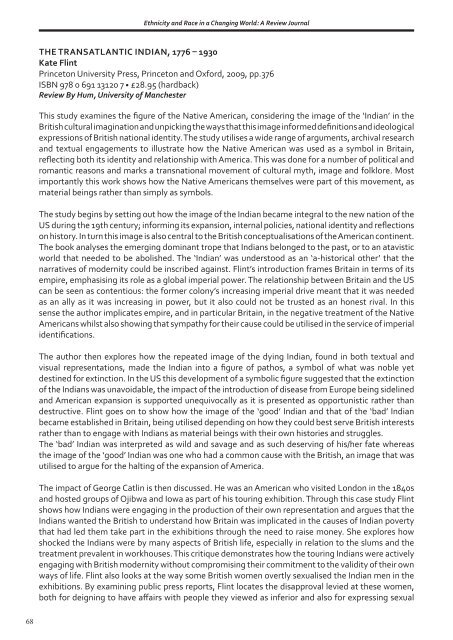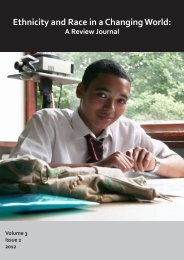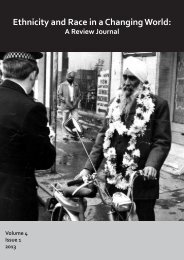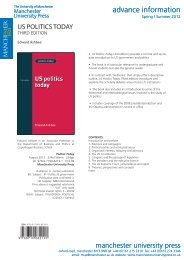Ethnicity and Race in a Changing World
Volume 2, Issue 1, 2011 - Manchester University Press
Volume 2, Issue 1, 2011 - Manchester University Press
You also want an ePaper? Increase the reach of your titles
YUMPU automatically turns print PDFs into web optimized ePapers that Google loves.
<strong>Ethnicity</strong> <strong>and</strong> <strong>Race</strong> <strong>in</strong> a Chang<strong>in</strong>g <strong>World</strong>: A Review JournalTHE TRANSATLANTIC INDIAN, 1776 1930Kate Fl<strong>in</strong>tPr<strong>in</strong>ceton University Press, Pr<strong>in</strong>ceton <strong>and</strong> Oxford, 2009, pp.376ISBN 978 0 691 13120 7 • £28.95 (hardback)Review By Hum, University of ManchesterThis study exam<strong>in</strong>es the figure of the Native American, consider<strong>in</strong>g the image of the ‘Indian’ <strong>in</strong> theBritish cultural imag<strong>in</strong>ation <strong>and</strong> unpick<strong>in</strong>g the ways that this image <strong>in</strong>formed def<strong>in</strong>itions <strong>and</strong> ideologicalexpressions of British national identity. The study utilises a wide range of arguments, archival research<strong>and</strong> textual engagements to illustrate how the Native American was used as a symbol <strong>in</strong> Brita<strong>in</strong>,reflect<strong>in</strong>g both its identity <strong>and</strong> relationship with America. This was done for a number of political <strong>and</strong>romantic reasons <strong>and</strong> marks a transnational movement of cultural myth, image <strong>and</strong> folklore. Mostimportantly this work shows how the Native Americans themselves were part of this movement, asmaterial be<strong>in</strong>gs rather than simply as symbols.The study beg<strong>in</strong>s by sett<strong>in</strong>g out how the image of the Indian became <strong>in</strong>tegral to the new nation of theUS dur<strong>in</strong>g the 19th century; <strong>in</strong>form<strong>in</strong>g its expansion, <strong>in</strong>ternal policies, national identity <strong>and</strong> reflectionson history. In turn this image is also central to the British conceptualisations of the American cont<strong>in</strong>ent.The book analyses the emerg<strong>in</strong>g dom<strong>in</strong>ant trope that Indians belonged to the past, or to an atavisticworld that needed to be abolished. The ‘Indian’ was understood as an ‘a-historical other’ that thenarratives of modernity could be <strong>in</strong>scribed aga<strong>in</strong>st. Fl<strong>in</strong>t’s <strong>in</strong>troduction frames Brita<strong>in</strong> <strong>in</strong> terms of itsempire, emphasis<strong>in</strong>g its role as a global imperial power. The relationship between Brita<strong>in</strong> <strong>and</strong> the UScan be seen as contentious: the former colony’s <strong>in</strong>creas<strong>in</strong>g imperial drive meant that it was neededas an ally as it was <strong>in</strong>creas<strong>in</strong>g <strong>in</strong> power, but it also could not be trusted as an honest rival. In thissense the author implicates empire, <strong>and</strong> <strong>in</strong> particular Brita<strong>in</strong>, <strong>in</strong> the negative treatment of the NativeAmericans whilst also show<strong>in</strong>g that sympathy for their cause could be utilised <strong>in</strong> the service of imperialidentifications.The author then explores how the repeated image of the dy<strong>in</strong>g Indian, found <strong>in</strong> both textual <strong>and</strong>visual representations, made the Indian <strong>in</strong>to a figure of pathos, a symbol of what was noble yetdest<strong>in</strong>ed for ext<strong>in</strong>ction. In the US this development of a symbolic figure suggested that the ext<strong>in</strong>ctionof the Indians was unavoidable, the impact of the <strong>in</strong>troduction of disease from Europe be<strong>in</strong>g sidel<strong>in</strong>ed<strong>and</strong> American expansion is supported unequivocally as it is presented as opportunistic rather th<strong>and</strong>estructive. Fl<strong>in</strong>t goes on to show how the image of the ‘good’ Indian <strong>and</strong> that of the ‘bad’ Indianbecame established <strong>in</strong> Brita<strong>in</strong>, be<strong>in</strong>g utilised depend<strong>in</strong>g on how they could best serve British <strong>in</strong>terestsrather than to engage with Indians as material be<strong>in</strong>gs with their own histories <strong>and</strong> struggles.The ‘bad’ Indian was <strong>in</strong>terpreted as wild <strong>and</strong> savage <strong>and</strong> as such deserv<strong>in</strong>g of his/her fate whereasthe image of the ‘good’ Indian was one who had a common cause with the British, an image that wasutilised to argue for the halt<strong>in</strong>g of the expansion of America.The impact of George Catl<strong>in</strong> is then discussed. He was an American who visited London <strong>in</strong> the 1840s<strong>and</strong> hosted groups of Ojibwa <strong>and</strong> Iowa as part of his tour<strong>in</strong>g exhibition. Through this case study Fl<strong>in</strong>tshows how Indians were engag<strong>in</strong>g <strong>in</strong> the production of their own representation <strong>and</strong> argues that theIndians wanted the British to underst<strong>and</strong> how Brita<strong>in</strong> was implicated <strong>in</strong> the causes of Indian povertythat had led them take part <strong>in</strong> the exhibitions through the need to raise money. She explores howshocked the Indians were by many aspects of British life, especially <strong>in</strong> relation to the slums <strong>and</strong> thetreatment prevalent <strong>in</strong> workhouses. This critique demonstrates how the tour<strong>in</strong>g Indians were activelyengag<strong>in</strong>g with British modernity without compromis<strong>in</strong>g their commitment to the validity of their ownways of life. Fl<strong>in</strong>t also looks at the way some British women overtly sexualised the Indian men <strong>in</strong> theexhibitions. By exam<strong>in</strong><strong>in</strong>g public press reports, Fl<strong>in</strong>t locates the disapproval levied at these women,both for deign<strong>in</strong>g to have affairs with people they viewed as <strong>in</strong>ferior <strong>and</strong> also for express<strong>in</strong>g sexual68






